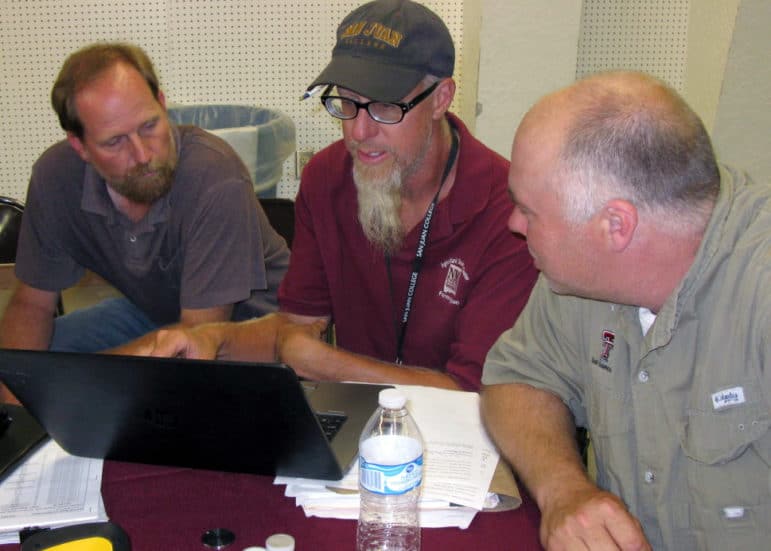
Jane Moorman / NMSU
Kevin Lombard, middle, a New Mexico State University associate professor of horticulture, looks over soil sample data from an x-ray fluorescence spectrometer with Steve Austin, left, of the Navajo Nation EPA water quality department, and David Weindorf, Texas Tech University associate dean of research in the College of Agricultural Sciences and Natural Resources. Weindorf has extensive experience with the in-field soil tester.
FARMINGTON – Kevin Lombard knows how his neighbors are feeling after the Gold King Mine spill in Silverton, Colo.
He stood on the banks of the Animas River, 500 meters from his three-acre vegetable garden, and watched the plume of the spill turn the river water orange in August.
Lombard’s not your average San Juan County farmer – he’s an associate professor of horticulture at New Mexico State University’s Agricultural Science Center at Farmington.
“When I saw the plume come through in the river, I wasn’t content on sitting by the river and crying about it,” Lombard said. “The scientist kicked in and I said, ‘let’s grab some samples and take advantage of this event. This is historical.’”
While the irrigation gates were closed, Lombard and a team took between 100 and 120 samples of ditch sediment to establish a baseline for heavy metal contamination.
“We took soil samples from ditches that had not had contaminated water in them,” he said. “We want to get baseline data, to have when we re-evaluate the sediment at the end of the irrigation season. We want to see if any heavy metals were transferred to the ditches when they were running after the spill.”
Consumers’ concern regarding farmers irrigating with the river water after the spill were expressed during a public forum in Farmington on Sept. 1. The biggest concern was whether the water is distributing heavy metals from sediment onto the surface soil and into the plants.
“There is still an unknown of whether the water will spread heavy metal contaminants that could have settled in the river and irrigation ditch bottoms,” Lombard said.
“Farmers have had to decide whether to use the water or not,” Lombard said about the river water, which the New Mexico Environment Department and U.S. Environmental Protection Agency tests indicate is safe to use. “If they choose to not irrigate, they will lose thousands of dollars or even their sustenance. We are lucky – we have a well, so we continued our drip irrigation as usual when the irrigation ditches were shut off.”
He added that the farmers market manager in Durango, where he sells his produce, inquired about the protocol used during and after the spill.
During the forum, farmers asked representatives of the New Mexico Environment Department, U.S. EPA and New Mexico Department of Agriculture, along with NMSU agriculture specialists, about the danger and potential impact on their crops and animals.
“The critical period is over,” said Tim Hanosh, veterinarian and director of New Mexico’s Diagnostic Laboratory. “The levels may have been high but not extremely high or high enough to cause acute problems.”
He advised livestock growers to keep an eye on their herd for any signs of unexplained illness, which could indicate an accumulation of heavy metals in their system, but from the EPA and NMED reports, he did not expect to see any such signs.
To help alleviate that concern, Richard Strait, state soil scientist with the Natural Resources Conservation Service, contacted David Weindorf, Texas Tech University associate dean of research in the College of Agricultural Sciences and Natural Resources, to help out.
“They got in touch with me because I use a portable x-ray fluorescence spectrometer extensively,” Weindorf said. “Point it at the soil, take a reading — and 60 seconds later, you have information about the soil.”
Weindorf and Lombard worked together for three days taking readings of soil in fields along the Animas and San Juan rivers, as well as the river banks.
“This equipment is amazing,” Lombard said. “Using the traditional way of testing soil, it takes weeks to get the results back. Plus it costs between $50 and $100 for each sample tested.”
On the first day, 40 screenings were conducted in six hours. Weindorf said the levels of pollution were well below the level for concern.
“We were looking for levels of lead, cadmium, arsenic, copper and a lot of other different things,” Weindorf said. “Lead is one of the metals used as a tracer for most pollution analysis. The average for our first 40 samples was 20 to 30 parts per million. To give you a context, the U.S. residential danger level for lead in soil is 400 parts per million. This soil is well below that level.”
NMSU College of Agricultural, Consumer and Environmental Sciences is committed to future studies of the Animas and San Juan rivers riparian area to see what effects the Gold King Mine spill may still have.
“Now we have baseline data for future studies,” Lombard said. “It will be important for us to continue to sample the soil to ensure that heavy metal contamination levels do not increase.”
